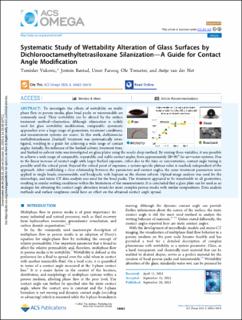| dc.description.abstract | To investigate the effects of wettability on multiphase flow in porous media, glass bead packs or micromodels are commonly used. Their wettability can be altered by the surface treatment method–silanization. Although silanization is widely used for glass wettability modification, comparable systematic approaches over a large range of geometries, treatment conditions, and measurement systems are scarce. In this work, dichlorooctamethyltetrasiloxane (Surfasil) treatment was systematically investigated, resulting in a guide for achieving a wide range of contact angles. Initially, the influence of the Surfasil solvent, treatment time, and Surfasil-to-solvent ratio was investigated on glass plates using the sessile drop method. By varying these variables, it was possible to achieve a wide range of comparable, repeatable, and stable contact angles, from approximately 20–95° for air–water systems. Due to the linear increase of contact angle with larger Surfasil exposure, either due to the time or concentration, contact angle tuning is possible until the critical point. Beyond the critical point of exposure, a system-specific plateau value is reached, independent of the approach. After establishing a clear relationship between the parameters and contact angles, the same treatment parameters were applied to single beads, micromodels, and beadpacks with heptane as the chosen solvent. Optical image analysis was used for the microchips, and micro CT data analysis was used for the bead packs. The treatment appeared to be transferable to all geometries, resulting in similar wetting conditions within the limitations of the measurements. It is concluded that a glass plate can be used as an analogue for obtaining the contact angle alteration trends for more complex porous media with similar compositions. Data analysis methods and surface roughness could have an effect on the obtained contact angle spread. | en_US |

